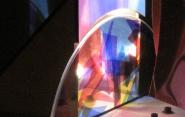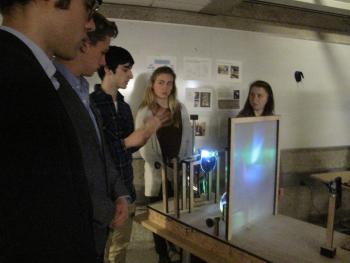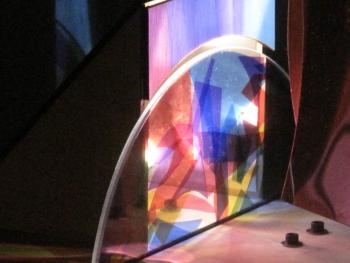Students' Engineering Innovation Sheds Light On Artist's Work

Two projects to come out of this fall semester of ENAS 118 shed new light on the work of artist Thomas Wilfred.
 Thomas Wilfred, who died in 1968, was an artist who used light as his medium. Earlier in the 20th century, Wilfred's status was once equal to those of Mark Rothko, Jackson Pollack and other contemporaries. Since then, his star has faded somewhat, partly due to the difficulty of putting his works on display. That's because much of the technology he used has fallen into obsolescence.
Thomas Wilfred, who died in 1968, was an artist who used light as his medium. Earlier in the 20th century, Wilfred's status was once equal to those of Mark Rothko, Jackson Pollack and other contemporaries. Since then, his star has faded somewhat, partly due to the difficulty of putting his works on display. That's because much of the technology he used has fallen into obsolescence.
His profile should rise, though, when the Yale University Art Gallery holds an exhibition of his work in 2017. One feature will be Wilfred's "Lumia Suite," on loan from the Museum of Modern Art in New York. Its parts have been stored inside a box for years, and Yale's art conservators have been at work bringing it back to life at the West Campus.
Getting it in working order was no easy trick, but with a lot of work and some ingenuity, it's pretty much back to original form. They've even commissioned a light artist to recreate one of the bulbs that Wilfred insisted was integral to the work.
"It's a very complicated project and very abstract in the beginning," said Carol Snow, Deputy Chief Conservator and the Alan J. Dworsky Senior Conservator of Objects for YUAG. "We want visitors to understand how these work."
That's where the two student projects come in. Group A (Tilman Bartelsmeyer, Arina Bykadorova, Lydia Keating, Charles Romano, and Vladyslav Vykhodets) and Group B (Briggs Bulkeley, Rhoni Gericke, Kacha Mahadumrongkul, Claire Mufson, and William Roberts) each  offered their own take on Wilfred's work. The projects were demonstrated at the final presentations of the Engineering Innovation & Design course this week.
offered their own take on Wilfred's work. The projects were demonstrated at the final presentations of the Engineering Innovation & Design course this week.
Students in both groups created models based designed to offer an interactive experience for visitors, and lead to a greater appreciation of Wilfred's intention as an artist.
Snow said they both do a great job of explaining the artwork without taking away from the often mysterious aspect of the swirling light patterns that Wilfred's machines produce.
"When [Wilfred's artwork] is on display in the art gallery, we're probably not going to show the inner-workings – the art is the image on the screen," said Snow, who acted as advisor to the two student teams. "So this is a way to have visitor interaction and explain the complicated mechanisms that are behind the screen. "
Keely Orgeman, curator of the exhibit, said she's excited to use the student projects when the exhibit goes on display.
"One thing I want to preserve in the exhibition itself is the aesthetic experience of the screens – the images on the screens, because that was a primary concern for Wilfred," said Orgeman, assistant curator of American paintings and sculpture for YUAG. "He wanted to maintain this this sort of mysticism, but it's still impportant for people to understand that these are analogue technologies."

